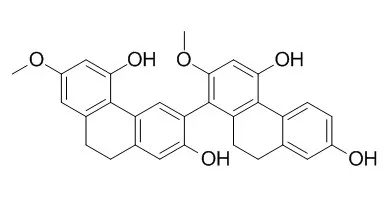| In vitro: |
| Nat Prod Commun. 2014 Jun;9(6):825-7. | | Chemical constituents of Dendrobium venustum and their antimalarial and anti-herpetic properties.[Pubmed: 25115090 ] |
METHODS AND RESULTS:
A MeOH extract from the whole plant Dendrobium venustum exhibited significant antimalarial and anti-herpetic activities. Bioassay-guided isolation of the plant extract resulted in the isolation of seven known phenolic compounds. Densiflorol B (3) and phoyunnanin E (6) showed the strongest antimalarial activity and a high selectivity index, whereas gigantol (2), batatasin III (5) and Phoyunnanin C (7) exhibited moderate activity. Compounds 2 and 5 also showed weak activity against the Herpes simplex virus.
CONCLUSIONS:
This study is the first report on the chemical and biological activities of D. venustum. | | J Asian Nat Prod Res. 2013;15(12):1256-64. | | Inhibitory activities on nitric oxide production of stilbenoids from Pholidota yunnanensis.[Pubmed: 24205813] |
METHODS AND RESULTS:
Three new stilbenoids, 1-(4'-hydroxybenzyl)-imbricatin, (E)-4'-hydroxy-2',3,3',5-tetramethoxystilbene, and (E)-3,4'-dihydroxy-2,6-bis(4-hydroxybenzyl)-2',3',5-trimethoxystilbene, together with 15 known stilbene derivatives, were isolated from Pholidota yunnanensis. Their structures were elucidated by spectroscopic methods and by comparison of their NMR data with those of related compounds. Furthermore, the inhibitory activities on nitric oxide (NO) production of the isolated compounds were examined in murine macrophages (RAW 264.7) activated by lipopolysaccharide. The cytotoxicity of 18 compounds was determined by the 3-(4,5-dimethylthiazol-2-yl)-5-(3-carboxymethoxyphenyl)-2-(4-sulfophenyl)-2H-tetrazolium assay.
CONCLUSIONS:
Among the tested compounds, eight stilbenoids, including three dihydrophenanthrenes, three stilbenes, and one bibenzyl derivative showed inhibitory effects on NO production without cytotoxicity with IC₅₀ values ranging from 4.07 to 7.77 μM, as compared to MG-132, which was used as a positive control (IC₅₀ of 0.10 μM). One dihydrophenanthrene, Phoyunnanin C, showed cytotoxic effects at the test concentrations. |
|






 Cell. 2018 Jan 11;172(1-2):249-261.e12. doi: 10.1016/j.cell.2017.12.019.IF=36.216(2019)
Cell. 2018 Jan 11;172(1-2):249-261.e12. doi: 10.1016/j.cell.2017.12.019.IF=36.216(2019) Cell Metab. 2020 Mar 3;31(3):534-548.e5. doi: 10.1016/j.cmet.2020.01.002.IF=22.415(2019)
Cell Metab. 2020 Mar 3;31(3):534-548.e5. doi: 10.1016/j.cmet.2020.01.002.IF=22.415(2019) Mol Cell. 2017 Nov 16;68(4):673-685.e6. doi: 10.1016/j.molcel.2017.10.022.IF=14.548(2019)
Mol Cell. 2017 Nov 16;68(4):673-685.e6. doi: 10.1016/j.molcel.2017.10.022.IF=14.548(2019)